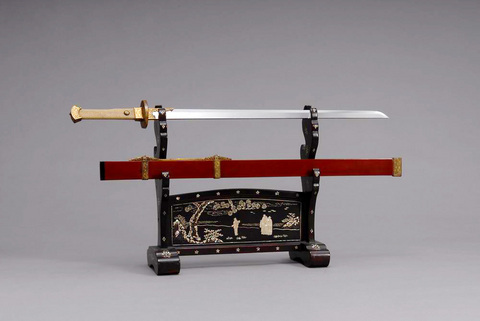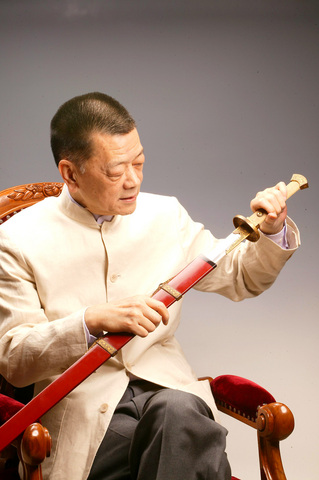Wellington Wang (王度) is a professional collector who, at 69, has established himself as something of a cultural celebrity. Warm, generous and free-spoken, he easily wins over his interlocutors with a childlike simplicity and his fascinating stories, drawing on his experience building up a collection of Chinese antiques numbering over 50 thousands pieces.
Wang has earned his reputation as a world-class collector for his collection of antique Chinese weaponry and Yixing (宜興) purple sand pottery ware (紫砂陶). He has also accumulated a extensive assortment of cultural and historical relics ranging from lacquerware, bronze and jade artifacts to ancient furniture and decorative art works such as thumb rings, snuff bottles, belt hooks and plaques. Local and international museums have often borrowed objects from Wang's collection when putting together major exhibitions on Chinese themes.
Wang's life-long infatuation with swords and knives began at a young age. As a seven-year-old boy, he found great pleasure in watching his general father and a graduate from the elite Whampoa Military Academy (黃埔軍校) polishing his army gear.

PHOTOS: COURTESY OF MEIMEN
After graduating from the National Chengchi University (政治大學), Wang went to study at New York University, where he began to seriously pursue his interest in collecting antique weaponry.
Contrary to the common belief that antique collectors need vast assets to back up their expensive hobbies, Wang started his lifelong interest working as a bus boy to put himself through college.
"After graduation, I got a job that paid US$200 a month, which was pretty much the same amount of money that went to my landlord. So I got a bank loan and opened a restaurant with friends and the chef who used to work for [the famous painter] Zhang Da-qian (張大千)," Wang recalled.

The first Sichuan restaurant in New York City immediately became a sensation and expanded into a restaurant chain. When his father's health deteriorated in 1984, Wang sold all his assets in the US and returned home.
Meanwhile, Wang had come to believe that as a collector he had an important mission in life, which was to recover China's historical relics lost in foreign lands.
"During China's Cultural Revolution, countless historical items were shifted abroad and ended up in the foreign hands ... . When I went to the Metropolitan Museum, it always hurt me to see Chinese cultural artifacts being kept in other people's museums," Wang said.
Unlike his entrepreneur friends such as Barry Lam (林百里) and Robert Tsao (曹興誠), who collect items from premiere auctions house for tax deductions and personal enjoyment, Wang has traveled across the world over the past 40 years, seeking out curios hidden in some of the most unlikely places.
"Years before when Yixing was just a remote village in Jiangsu Province, I would go there once a year for the purple sand pottery and tea pots. Occasionally, cultural artifacts found their way into Wang's hands by chance, as these object "have a spirit," according to Wang.
Immersing himself in books and museums, the self-taught master in ancient Chinese artifacts has published 15 illustrated books on his personal collection, which is classified into 38 categories.
Yet the unparalleled achievement has come at a hefty price.
"Nobody believes that with a collection worth NT$1 billion, I am in fact in debt. I just keep on collecting things as long as I can afford to ... My wife says I'm a nut case," Wang said.
Wang's wife may have a point, since in this collector's dictionary, "as long as I can afford" means borrowing money to bring antiques home.
Giving away a life of luxury for his calling, the aging collector's urgent wish is to find his massive collection a new home in Taiwan, hoping that the government and billionaire entrepreneurs can lend a helping hand to let this cultural heritage stay where it belongs.
"The Japanese have offered high figures for my collection time and again, but I have turned down the offers. These antiques are a manifestation of Chinese culture and once they are lost, it's impossible to recover them," said Wang.
Last year, the collector came across the path of the like-minded Lee Feng-san (李鳳山), founder of Meimen Qigong and Culture Center (梅門一氣流行養生學苑), who has dedicated himself in reviving the ancient Chinese philosophy of self-cultivation through qigong. An unprecedented exhibition has emerged from this new friendship: an exhibition of swords taken from Wang's collection, which will be shown at the center's gallery in Hsinchu later this month.
Entitled The Swords of the Emperor (王者之風), the exhibition features imperial swords from the Qing and Ming Dynasties, as well as swords and daggers dating back as far as the Warring States period (475BC to 221BC).
The Swords of the Emperor is slated to take place at the Meimen Gallery, B1, 192 Tungkuang Rd, Hsinchu City (新竹市東光路192號B1) from June 16 to Sept. 2. For more information, call (03) 574-5874 or visit www.meimen.org.

Wooden houses wedged between concrete, crumbling brick facades with roofs gaping to the sky, and tiled art deco buildings down narrow alleyways: Taichung Central District’s (中區) aging architecture reveals both the allure and reality of the old downtown. From Indigenous settlement to capital under Qing Dynasty rule through to Japanese colonization, Taichung’s Central District holds a long and layered history. The bygone beauty of its streets once earned it the nickname “Little Kyoto.” Since the late eighties, however, the shifting of economic and government centers westward signaled a gradual decline in the area’s evolving fortunes. With the regeneration of the once

Even by the standards of Ukraine’s International Legion, which comprises volunteers from over 55 countries, Han has an unusual backstory. Born in Taichung, he grew up in Costa Rica — then one of Taiwan’s diplomatic allies — where a relative worked for the embassy. After attending an American international high school in San Jose, Costa Rica’s capital, Han — who prefers to use only his given name for OPSEC (operations security) reasons — moved to the US in his teens. He attended Penn State University before returning to Taiwan to work in the semiconductor industry in Kaohsiung, where he

In February of this year the Taipei Times reported on the visit of Lienchiang County Commissioner Wang Chung-ming (王忠銘) of the Chinese Nationalist Party (KMT) and a delegation to a lantern festival in Fuzhou’s Mawei District in Fujian Province. “Today, Mawei and Matsu jointly marked the lantern festival,” Wang was quoted as saying, adding that both sides “being of one people,” is a cause for joy. Wang was passing around a common claim of officials of the People’s Republic of China (PRC) and the PRC’s allies and supporters in Taiwan — KMT and the Taiwan People’s Party — and elsewhere: Taiwan and

Perched on Thailand’s border with Myanmar, Arunothai is a dusty crossroads town, a nowheresville that could be the setting of some Southeast Asian spaghetti Western. Its main street is the final, dead-end section of the two-lane highway from Chiang Mai, Thailand’s second largest city 120kms south, and the heart of the kingdom’s mountainous north. At the town boundary, a Chinese-style arch capped with dragons also bears Thai script declaring fealty to Bangkok’s royal family: “Long live the King!” Further on, Chinese lanterns line the main street, and on the hillsides, courtyard homes sit among warrens of narrow, winding alleyways and